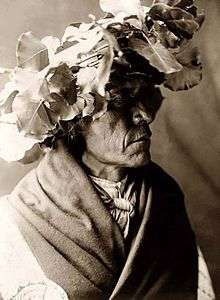Wreath (attire)

A wreath (Ancient Greek: στέφανος stéfanos, Latin: corona),[1] for attire purposes, is a headdress made of leaves, grasses, flowers or branches. It is typically worn in festive occasions and on holy days and has a long history and association with ancient pageants and ceremonies. Outside of occasional use, the wreath can also be used as a crown. The wreath most often has an annular geometric construction.
Ancient Greece
The wreath is associated with Greek attire and celebrations since ancient times, continuing a tradition to the modern day Olympic ceremonies. Ancient coinage minted by early Greek city-states often depicted a divinity or other figure with a wreath. Wearing a wreath may have also had a mediating role by helping the wearer get closer to a specific deity. Different plants were dedicated to various gods: oak to Zeus, laurel to Apollo, herbs to Demeter, grapevine to Dionysos and myrtle to Aphrodite.[2] Wreaths were also used to decorate the hermae,[3] stone pillars surmounted with the head of a god or distinguished mortal.
Ancient Rome
Wreaths were also part of clothing in Rome. Laurel wreaths were used by military and public officials in parades. Wreaths made out of olive leaves were worn by consuls and senators. During a period of the ancient Roman civilization, it was a custom for soldiers rescued from a siege to present a wreath made of grass to the commander of the rescuing force.[4]
Christianity
In Christianity, the wreath represents the resurrection of Christ and therefore eternal life, more appropriately the victory of life over death.[5] The crown of thorns was placed on the head of Jesus at his execution by crucifixion and became a symbol of the Passion.
Ukraine
A tradition of the Ukrainian wreath,[6] a headdress made of leaves, flowers and branches worn by girls and young unmarried women, dates back to the old Slavic customs that predate the Christianization of Rus. The flower wreath remains a part of the Ukrainian national costume and is worn on festive occasions and on holy days.
Polynesia
Floral wreaths and garlands known as lei (Hawaii) are ubiquitous in Polynesia as both ornamental attire and gifts representative of affection or respect. Worn by men and women around the neck or around the head and commonly fashioned of flowers, leaves, vines and plant fiber.
Indigenous peoples of the Americas
Wreaths are part of the culture and legends of indigenous peoples of the Americas. The Cheyenne people wore wreaths during sacred ceremonies, rituals, dances and songs and head wreaths were usually made from willow, cottonwood or sage.[7]
Gallery

A Ukrainian wreath Wiccan wedding wreaths 
Druid wreaths 
Lithuanian wreaths 
Wreath of Brittany 
Wreath of Marquesas 
Cheyenne Indian wreath _-_n._0269_-_Boy_with_laurel_wreath.jpg)
Sicilian laurel wreath
See also
Notes
- ↑ Smith, William (1870). Dictionary of Greek and Roman Antiquities. p. 359.
- ↑ Rogić, D. (2012). Wreath - its Use and Meaning in Ancient Visual Culture. p. 342.
- ↑ Theophrastus, Characters XVI
- ↑ T.Arnold, 1871
- ↑ Rogić, D. (2012). Wreath - its Use and Meaning in Ancient Visual Culture. p. 352.
- ↑ O.P.Tracz, 1999
- ↑ Grinnell, George Bird (1962). The Cheyenne Indians. 1. pp. 28, 269, 330.
References
- Thomas Arnold (1871) History of Rome
- Orysia Paszczak Tracz, Vinok, vinochok, The Ukrainian Weekly, August 1, 1999
External links
| Wikimedia Commons has media related to |